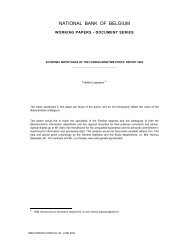A multi-factor model for the valuation and risk management of ...
A multi-factor model for the valuation and risk management of ...
A multi-factor model for the valuation and risk management of ...
Create successful ePaper yourself
Turn your PDF publications into a flip-book with our unique Google optimized e-Paper software.
1 Introduction<br />
Banks create a mismatch between <strong>the</strong> maturity <strong>of</strong> <strong>the</strong>ir assets <strong>and</strong> liabilities by taking short-term<br />
dem<strong>and</strong> deposits <strong>and</strong> granting long-term loans. Deposit accounts are hence at <strong>the</strong> core <strong>of</strong> banks’<br />
maturity trans<strong>for</strong>mation function. This paper analyzes <strong>the</strong> <strong>valuation</strong> <strong>and</strong> <strong>risk</strong> <strong>management</strong> <strong>of</strong><br />
deposits.<br />
In general deposit accounts can be divided into two classes. A …rst class consists <strong>of</strong> deposit accounts<br />
<strong>for</strong> which <strong>the</strong> e¤ective time to maturity is identical to <strong>the</strong> contractual time to maturity <strong>and</strong> <strong>for</strong><br />
which <strong>the</strong> deposit rate dynamics are close to <strong>the</strong> corresponding-maturity market rate dynamics.<br />
Term or time deposit accounts are typical examples <strong>of</strong> this class <strong>of</strong> deposit accounts. No special<br />
measurement <strong>and</strong> <strong>valuation</strong> problems arise <strong>for</strong> this class <strong>of</strong> deposits as <strong>the</strong>y resemble simple zero<br />
coupon bonds. A second class <strong>of</strong> deposit accounts is characterized by <strong>the</strong> fact that <strong>the</strong> e¤ective<br />
time to maturity may substantially exceed <strong>the</strong> contractual time to maturity <strong>and</strong> is remunerated<br />
at a (‡uctuating) margin or spread below market rates. In <strong>the</strong> remainder <strong>of</strong> this paper we refer to<br />
<strong>the</strong> latter deposit accounts as nonmaturity or dem<strong>and</strong> deposit accounts (NMAs, DDAs).<br />
From <strong>the</strong> viewpoint <strong>of</strong> a depositor, DDAs are relatively straight<strong>for</strong>ward …nancial instruments.<br />
However, from <strong>the</strong> viewpoint <strong>of</strong> a deposit-issuing bank or bank supervisor, DDAs are notoriously<br />
di¢ cult to value <strong>and</strong> manage. Three important complexities arise. First, DDAs are subject to<br />
important behavioral relationships. More speci…cally, individual depositors are free to withdraw<br />
part or all <strong>of</strong> <strong>the</strong>ir balances <strong>and</strong> deposit issuing banks have <strong>the</strong> discretion to change <strong>the</strong> rate that is<br />
paid to <strong>the</strong> deposit holder. Depositor <strong>and</strong> bank behavior make <strong>the</strong> <strong>management</strong> <strong>of</strong> savings deposits’<br />
interest rate <strong>risk</strong> challenging, in particular because <strong>the</strong>ir exercise time are not independent. For<br />
example, if banks were not, or only partially, to raise deposit rates in response to an increase in<br />
market rates, depositors might withdraw <strong>the</strong>ir balances or part <strong>of</strong> <strong>the</strong>m in order to invest <strong>the</strong>ir<br />
funds at <strong>the</strong> higher market rates. This makes clear that DDA’s interest, repricing, <strong>and</strong> volume<br />
<strong>risk</strong>s should best be studied jointly within one coherent framework. A second complexity is that<br />
DDAs are not actively traded on a liquid market. Their value is only occasionally disclosed in <strong>the</strong><br />
rare event that a deposit issuing bank is taken over by ano<strong>the</strong>r or when deposit bank branches<br />
are sold. Hence, <strong>valuation</strong> <strong>model</strong>s are required without <strong>the</strong> ability to backtest or calibrate <strong>the</strong>m.<br />
Third, DDAs are retail products. They supply depositors with liquidity <strong>and</strong> payment services.<br />
As such, <strong>the</strong>ir <strong>valuation</strong> <strong>and</strong> pricing may be a¤ected by <strong>the</strong>se services <strong>and</strong> by <strong>the</strong> collection <strong>and</strong><br />
servicing costs which <strong>the</strong> bank incurs to issue deposits.<br />
Banks <strong>and</strong> supervisors have been <strong>and</strong> are still very much interested in <strong>the</strong> development <strong>of</strong> a best<br />
practice approach <strong>for</strong> <strong>the</strong> di¢ cult issue <strong>of</strong> <strong>the</strong> <strong>valuation</strong> <strong>and</strong> <strong>risk</strong> <strong>management</strong> <strong>of</strong> dem<strong>and</strong> deposits.<br />
The reason is that DDAs play a prominent role in <strong>the</strong> funding structure <strong>of</strong> deposit issuing banks<br />
<strong>and</strong> that <strong>the</strong> interest rate sensitivity <strong>of</strong> deposit accounts is a key issue in banks’asset <strong>and</strong> liability<br />
<strong>management</strong> (ALM). 1 When market interest rates increase, deposit liabilities typically depreciate<br />
in value (in o<strong>the</strong>r words, "deposit premiums" 2 appreciate in value), <strong>and</strong> vice versa. However, given<br />
<strong>the</strong> complexities sketched above it is no surprise that this issue still is actively discussed among<br />
bankers <strong>and</strong> academic researchers. An international consensus is also actively promoted in <strong>the</strong><br />
context <strong>of</strong> Pillar II <strong>of</strong> <strong>the</strong> New Basel Accord <strong>and</strong> by <strong>the</strong> European Commission (EC). 3 Despite all<br />
1 Kuritzkes <strong>and</strong> Schuermann (2006) …nd that structural asset/liability <strong>risk</strong> accounts <strong>for</strong> about 20% <strong>of</strong> total earnings<br />
volatility. Market <strong>and</strong> credit <strong>risk</strong> account <strong>for</strong> 50% <strong>of</strong> total earning volatility <strong>and</strong> non…nancial <strong>risk</strong>s <strong>for</strong> <strong>the</strong> remaining<br />
30%. The authors plead <strong>for</strong> future <strong>risk</strong> <strong>management</strong> developments to focus upon <strong>the</strong> <strong>risk</strong>s that are <strong>the</strong> least known<br />
<strong>and</strong> that have a signi…cant impact on earnings volatility.<br />
2 "Deposit premium" will be de…ned below. Intuitively, it can be understood as <strong>the</strong> di¤erence between <strong>the</strong> par<br />
value <strong>of</strong> deposits <strong>and</strong> <strong>the</strong> "economic value" <strong>of</strong> <strong>the</strong> deposit liability. Loosely, <strong>the</strong> fact that a bank is able to …nance<br />
itself by a relatively cheap <strong>and</strong> stable source <strong>of</strong> funding may represent a kind <strong>of</strong> "deposit premium" or "net asset<br />
value".<br />
3 The Basel Committee issued principles <strong>for</strong> <strong>the</strong> <strong>management</strong> <strong>and</strong> supervision <strong>of</strong> interest rate <strong>risk</strong> (BIS (2004)).<br />
The New Capital Accord states: "To facilitate supervisors’ monitoring <strong>of</strong> interest rate <strong>risk</strong> exposures across institutions,<br />
banks must provide <strong>the</strong> results <strong>of</strong> <strong>the</strong>ir internal measurement systems, expressed in terms <strong>of</strong> <strong>the</strong> threat<br />
1
















